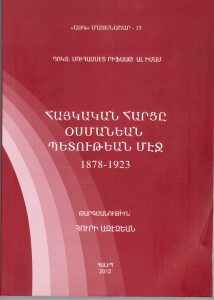![]() Muhammad Rifaat al-Imam
Muhammad Rifaat al-Imam
![]() Arevelk
Arevelk
![]() Syria
Syria
![]() Essay
Essay
![]() Armenian
Armenian
Translated from Arabic into Armenian by Hori Azazian
The first chapter of the book examines Armenians’ lives in the Ottoman Empire since the seizure of the Armenian regions that were called "Western Armenia", through the Armenian intellectual awakening and until the transformation of the Armenian question into an international affair after the Berlin Conference in 1878, and the Armenian, regional and international reactions that resulted from it. This transformation led to the massacre of defenseless Armenians during the reign of Sultan Abdul Hamid II (1876-1909).
Muhammad Rifaat al-Imam then reviews the growth and amplification of the Turkish nationalism that pushed the Unionists and Young Turks to eradicate the Armenian race from the Turkish demographic structure. This second chaper demonstrates how the Unionists committed the first genocide against the Armenians at the beginning of the twentieth century. It also follows the birth of the Republic of Armenia in 1918 and the circumstances of its development.
In the third chapter, the author traces the emergence of Kemalism in Anatolia and its impact on the Armenian people. Then he examines the Kemalist wars in Anatolia and beyond the Caucasus and the accession of Armenia to the Soviet bloc, and thus the assassination of the Armenian cause and the rights of the Armenian people at the Lausanne Conference in 1923.
Muhammad Rifaat al-Imam is an Egyptian researcher, historian and writer. He is the head of the Department of History at Damanhour University, and a member of the Council of Armenian Studies at Cairo University. He is a specialist of Armenian history.
ترجمه من العربية هوري عزازيان
يبحث القسم الأوّل من كتاب القضية الأرمنية في الدولة العثمانية، 1878 – 1923 في أوضاع الأرمن في الدولة العثمانيّة منذ استيلاء الأخيرة على المناطق الأرمنيّة التي كانت تسمّى "أرمينيا الغربية". يتوقّف هذا القسم عند انبعاث اليقظة الفكريّة الأرمينيّة وتحوّل المسألة الأرمينيّة إلى قضيّة دوليّة عقب مؤتمر برلين، عام 1878، وما تمخّض عنه وأدّى إلى اندلاع المذابح ضدّ الأرمن العزّل، في عهد السلطان عبد الحميد الثاني (1876-1909).
يستعرض محمّد رفعت الإمام، في الفصل الثاني، صعود النزعة القوميّة التركيّة التي دفعت الاتّحاديين والأتراك الشبّان إلى القضاء على الأرمن، الذين نُظر إليهم ككيان غريب على بنية المجتمع التركي. هكذا، ارتكب الاتّحاديون أوّل جريمة إبادة بحقّ الشعب الأرمني في مطلع القرن العشرين. كما نتابع، مع الكاتب، ميلاد جمهورية أرمينيا، عام 1918، وظروف نموّها.
يعالج الكاتب، في الفصل الثالث، ظهور الكماليّة في الأناضول وأثرها على الشعب الأرمني. ثمّ يبحث في الحروب الكماليّة في الأناضول وما وراء القوقاز، وانضمام أرمينيا إلى الكتلة السوفييتية، وتقويض القضيّة الأرمنيّة وحقوق الشعب الأرمني العادلة في مؤتمر لوزان، عام 1923.
محمد رفعت الإمام باحث ومؤرّخ وكاتب مصري، يرأس قسم التاريخ الحديث والمعاصر في جامعة دمنهور ويعمل محاضراً فيها. وهو أيضاً عضو مجلس الدراسات الأرمنيّة في جامعة القاهرة ومختصّ بالتاريخ الأريميني.




